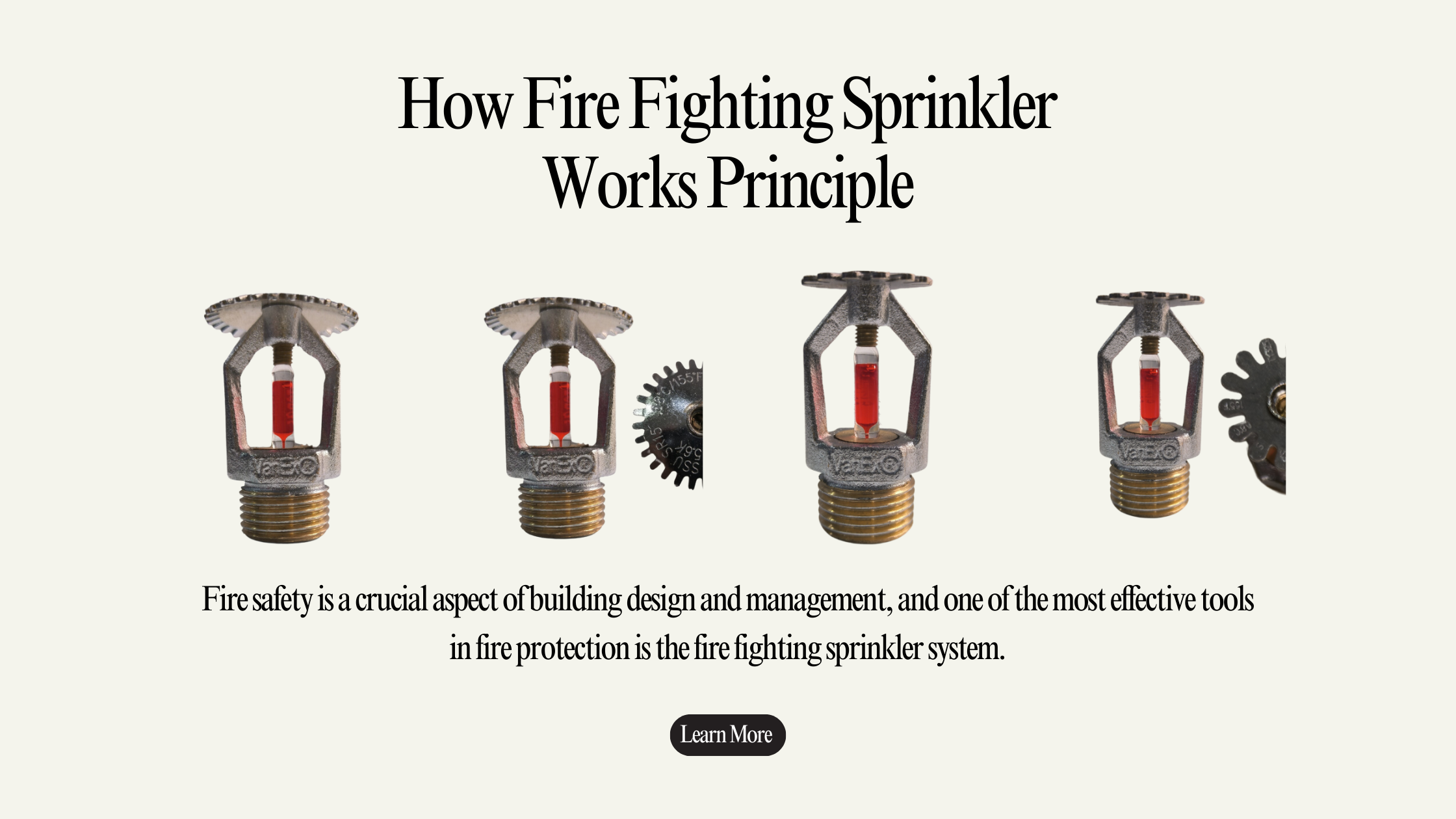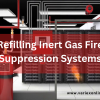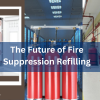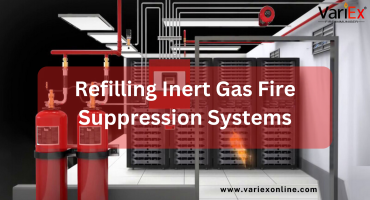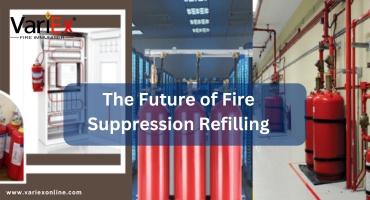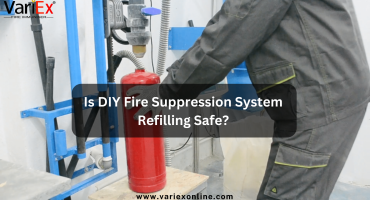![]()
Fire Immuniser
+91-7829629111
Email: info@variex.in
Varistor Technologies Pvt. Ltd.
Block-1, First Floor, Ardente Office One, Hoodi Circle, ITPL Main Road, Bengaluru, Karnataka 560048, IN
How Fire Fighting Sprinkler Works Principle
How Fire Fighting Sprinkler Works Principle
Fire safety is a crucial aspect of building design and management, and one of the most effective tools in fire protection is the fire fighting sprinkler system. Understanding the principles behind how these systems work can significantly enhance their effectiveness and improve safety in various environments. This comprehensive guide delves into the fundamental principles of fire fighting sprinklers, covering their design, operation, and impact on fire safety.
1. Introduction to Fire Fighting Sprinklers
Fire fighting sprinklers are an essential component of modern fire protection systems, designed to automatically detect and extinguish fires. They are used in residential, commercial, and industrial settings to minimize property damage, save lives, and provide a critical line of defense against uncontrolled fires.
The basic principle of a fire sprinkler system is straightforward: when a fire occurs, the system detects the heat and automatically activates to release water, suppressing the flames. While the concept seems simple, the engineering and technology behind these systems are complex and sophisticated, ensuring reliable performance in emergencies.
2. Principles of Fire Detection and Suppression
a) Heat Detection
The primary mechanism for activating a fire sprinkler system is heat detection. Sprinkler heads contain a heat-sensitive element designed to respond to rising temperatures caused by a fire. The two most common types of heat-sensitive elements are:
- Glass Bulbs: These bulbs are filled with a colored liquid that expands when heated. The glass shatters at a specific temperature (typically between 135°F and 165°F), allowing the sprinkler to open and release water.
- Fusible Links: These are metal elements that melt when exposed to high temperatures. When the link melts, it releases the sprinkler's plug, allowing water to flow.
b) Activation Mechanism
Once the heat-sensitive element is triggered, the activation mechanism begins. Only the sprinkler heads in the immediate vicinity of the fire activate, preventing unnecessary water discharge in unaffected areas. This targeted approach reduces water damage and conserves resources.
c) Water Discharge
Once activated, the sprinkler head allows pressurized water to flow from the pipes, dispersing it in a specific spray pattern. The water is aimed at the base of the fire, cooling the flames and limiting their spread. Sprinklers are designed to deliver a precise amount of water over a defined area, ensuring efficient fire suppression.
3. Types of Fire Sprinkler Systems
Different environments and fire risks require specific types of fire sprinkler systems, each designed with its own principles of operation.
a) Wet Pipe Systems
Wet pipe systems are the most common type of fire sprinkler system. In these systems, the pipes are filled with water at all times, ensuring immediate discharge when a sprinkler is activated. The simplicity of wet pipe systems contributes to their reliability and efficiency.
b) Dry Pipe Systems
Dry pipe systems are used in environments where freezing temperatures can occur. The pipes are filled with pressurized air or nitrogen instead of water, preventing freezing. When a sprinkler activates, the air pressure drops, allowing water to flow into the pipes and out of the activated sprinkler head.
c) Deluge Systems
Deluge systems are designed for high-hazard areas where rapid water discharge is critical. In these systems, all sprinkler heads are open, and water is released simultaneously when a fire detection system triggers the deluge valve. This system is often used in settings such as chemical plants or aircraft hangars.
d) Pre-action Systems
Pre-action systems are a hybrid of wet and dry systems, designed to minimize the risk of accidental water discharge. In a pre-action system, the pipes are dry until two conditions are met: a fire is detected, and the pre-action valve opens. This ensures that only activated sprinklers release water, making it suitable for sensitive environments like data centers and museums.
e) Foam Water Sprinkler Systems
Foam water systems are specialized systems that mix water with foam to suppress flammable liquid fires. The foam creates a barrier that smothers the flames and prevents re-ignition. This system is commonly used in industries handling hazardous materials.
4. Core Components of a Fire Sprinkler System
A fire sprinkler system is composed of various components, each playing a critical role in the system's overall effectiveness. Understanding these components helps clarify how fire fighting sprinklers operate.
a) Sprinkler Heads
Sprinkler heads are the most visible part of the system and are strategically placed throughout a building. There are different types of sprinkler heads, including:
- Pendant Sprinklers: Hang from ceilings and disperse water downward in a circular pattern.
- Upright Sprinklers: Point upwards and are used in areas where pipes are exposed.
- Sidewall Sprinklers: Mounted on walls, these sprinklers are effective in areas where ceiling installation is challenging.
- Concealed Sprinklers: Hidden behind decorative covers, these sprinklers drop away when activated, providing a more aesthetically pleasing appearance.
b) Pipes and Fittings
The piping network carries water from the supply to the sprinkler heads. Pipes can be made from various materials, including steel, copper, and CPVC plastic. The piping configuration is determined by the type of sprinkler system and the layout of the building.
c) Control Valves
Control valves are crucial for regulating water flow into the sprinkler system. They can be manually operated or automatic, ensuring that water is available when needed and can be shut off when the fire has been controlled.
d) Water Supply
A reliable water source is essential for the sprinkler system to function. Water can come from municipal sources, dedicated tanks, or fire pumps. The water supply must provide adequate pressure and flow to meet the system's requirements.
e) Alarm and Monitoring Systems
Sprinkler systems are often integrated with fire alarm systems, providing immediate notification when a fire is detected. These systems ensure that occupants are alerted, and emergency services are notified as soon as possible.
5. Design Principles of Fire Sprinkler Systems
The design of a fire sprinkler system is critical to its effectiveness and is based on several key principles:
a) Coverage Area
The design must ensure adequate coverage of all areas within a building, taking into account the specific fire risks associated with different spaces. The distance between sprinkler heads is determined by factors such as ceiling height, room dimensions, and the type of sprinkler head used.
b) Water Supply and Pressure Requirements
The system must be designed to work with the available water supply and pressure. Fire protection engineers conduct hydraulic calculations to determine the necessary water flow rates and pressures needed to ensure effective fire suppression.
c) Occupancy Classification
Different types of buildings have varying fire hazards. The system's design must account for the occupancy classification, which categorizes buildings based on the level of fire risk. For instance, residential buildings have different requirements compared to warehouses or industrial facilities.
d) Compliance with Fire Codes
All sprinkler systems must comply with local and national fire safety regulations, such as those established by the National Fire Protection Association (NFPA). These codes dictate installation, maintenance, and inspection standards.
6. The Science Behind Fire Suppression
Understanding the science behind fire suppression helps clarify why fire sprinkler systems are effective.
a) Fire Dynamics
Fire dynamics is the study of how fires start, spread, and are extinguished. Several factors influence fire behavior, including the materials involved, ventilation, and heat release rates. Fire sprinklers are designed to disrupt these factors by cooling the flames and reducing the heat available for combustion.
b) Cooling Effect of Water
Water is effective in extinguishing fires due to its ability to absorb heat. When water is sprayed onto a fire, it cools the flames and surrounding materials, which reduces the temperature below the ignition point. This cooling effect is crucial for controlling and extinguishing fires.
c) Smothering Effect of Foam
In foam water systems, the foam creates a barrier that smothers the fire by cutting off its oxygen supply. This is especially effective for flammable liquid fires, where conventional water may not be sufficient.
7. Benefits of Fire Fighting Sprinkler Systems
Fire fighting sprinkler systems offer numerous advantages, making them a vital component of fire safety strategies:
a) Rapid Fire Suppression
Sprinkler systems can suppress fires quickly, often before they escalate into major incidents. This rapid response significantly reduces property damage and potential injuries.
b) Enhanced Life Safety
By controlling fires and allowing for safe evacuation, sprinkler systems enhance life safety for occupants. Many lives have been saved due to the quick activation of sprinklers in emergencies.
c) Lower Insurance Premiums
Insurance companies often provide discounts for buildings equipped with fire sprinkler systems, recognizing the reduced risk of catastrophic damage. This financial incentive encourages more property owners to invest in fire protection.
d) Minimal Water Damage
Contrary to common misconceptions, the amount of water discharged by sprinklers is usually less than that used by firefighters with hoses. This targeted water application minimizes potential water damage while effectively controlling the fire.
8. Common Misconceptions About Fire Sprinkler Systems
Understanding the realities of fire sprinkler systems helps dispel myths that can deter property owners from installing them:
a) "All Sprinklers Activate at Once"
One of the most prevalent myths is that all sprinkler heads activate simultaneously during a fire. In reality, only the heads nearest to the heat source activate, preventing unnecessary water damage in unaffected areas.
b) Risk of Accidental Activation
Sprinkler systems are designed to activate only under specific conditions, such as high temperatures. Accidental activation is rare, and the likelihood of a sprinkler head activating without a fire is extremely low.
c) Water Damage Concerns
While it is true that water can cause damage, the potential damage from an uncontrolled fire far outweighs the water damage caused by a sprinkler system. Properly designed and maintained systems help mitigate water-related issues.
9. Maintenance and Inspection of Fire Sprinkler Systems
Regular maintenance and inspection are vital to ensuring that fire sprinkler systems function effectively when needed:
a) Routine Inspections
Fire sprinkler systems should be inspected at least once a year by qualified professionals. Inspections include checking for leaks, verifying that sprinkler heads are unobstructed, and ensuring that control valves are functional.
b) Testing
Routine testing of the system is essential to ensure proper functionality. This may include flow tests to verify water pressure and volume, as well as functional tests of alarms and monitoring systems.
c) Compliance with Regulations
Maintenance practices must comply with local fire codes and regulations, ensuring that systems remain in good working order and are ready for emergency response.
10. Technological Innovations in Fire Sprinkler Systems
Advancements in technology are enhancing the effectiveness and efficiency of fire sprinkler systems:
a) Smart Sprinkler Systems
Modern fire sprinkler systems are increasingly integrated with building management systems and the Internet of Things (IoT). These smart systems provide real-time monitoring and data analytics, allowing for proactive maintenance and improved response times.
b) Eco-Friendly Solutions
Innovations in fire suppression technology have led to more environmentally friendly solutions, such as water-efficient systems and the use of biodegradable foams. These advancements help reduce the environmental impact of fire protection.
c) Integrated Fire Safety Systems
New technologies are allowing for the integration of fire sprinklers with advanced fire detection, alarm systems, and emergency response technologies. This comprehensive approach enhances overall fire safety.
Conclusion
Fire fighting sprinkler systems are a vital component of modern fire protection strategies, designed to detect, control, and suppress fires effectively. Understanding the principles behind how these systems work, from their core components to the science of fire suppression, is essential for optimizing their performance and enhancing safety in various environments.
With regular maintenance, adherence to safety regulations, and the incorporation of technological innovations, fire sprinkler systems will continue to play a critical role in protecting lives and property from the devastating effects of fire. As building designs evolve and fire risks change, ongoing education and awareness about fire sprinkler systems remain essential in promoting fire safety for years to come.
Frequently Asked Questions
Fire fighting sprinkler systems detect fires through heat-sensitive elements in the sprinkler heads, such as glass bulbs or fusible links. When the temperature rises due to a fire, these elements activate, allowing water to flow and suppress the flames.
There are several types of fire sprinkler systems, including wet pipe systems (filled with water at all times), dry pipe systems (filled with pressurized air), pre-action systems (require two triggers), deluge systems (release water from all heads simultaneously), and foam water systems (use foam to suppress flammable liquid fires).
No, only the sprinkler heads closest to the heat source activate when a fire occurs. This targeted approach minimizes water damage in unaffected areas while effectively suppressing the fire.
Fire sprinkler systems offer numerous benefits, including rapid fire suppression, enhanced life safety for occupants, reduced property damage, potential insurance discounts, and minimal water damage compared to traditional firefighting methods.
Final Say
At VariEx.in and VariexOnline.com, we specialize in supplying and installing top-quality fire fighting systems and equipment. From fire extinguishers to advanced suppression systems, we offer comprehensive solutions tailored to your needs. Our experienced team ensures precise installation and maintenance for optimal safety.
Trust VariEx for reliable fire protection. Contact us online or call 7829629111 to learn more.
We specialize in manufacturing, supplying, and distributing a comprehensive range of fire fighting equipment, including state-of-the-art fire extinguishers. Read our most searched blogs and find interesting information on topics such as how to use a fire extinguisher, how to calculate fire fighting water tank capacity, fire extinguisher refilling, obtaining a Fire NOC, understanding fire fighting systems, types of fire protection systems, the fire hydrant system, and the fire sprinkler system. These resources provide essential knowledge for ensuring safety and compliance with fire safety regulations. Additionally, you can explore guides on the maintenance of fire protection equipment, the latest advancements in fire safety technology, and best practices for fire risk assessment and management.
Our expertise extends to fire alarm systems, fire hydrant systems, and fire suppression systems, including fire sprinklers. Each product meets rigorous international standards for reliability and performance, ensuring effective fire safety products tailored to diverse applications and industries. Additionally, we are providing Fire Extinguisher Refilling and AMC services to ensure ongoing maintenance and operational readiness of fire safety equipment.


